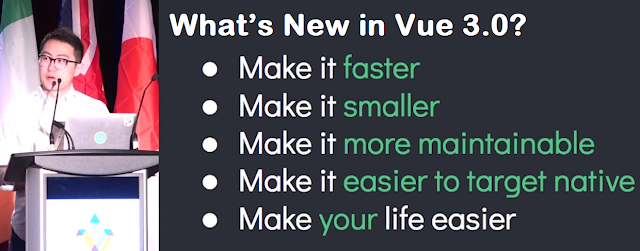Vue.js
is an open source JavaScript framework for building user interfaces and
single-page applications.
I hope you enjoyed with this post.
The
Vue 3.0 is faster, smaller, maintainable source
code, easier to use, and more native-friendly now.
What’s New in Vue 3.0?
There are some added new features and
improvements as following:-
1. Improved
TypeScript support
2. Easier
to use Vue with any platform like Web, iOS, or Android
3. Making
framework size is too smaller (20kb gzipped to 10kb gzipped)
4. Virtual
DOM Rewrite
5. Static
Tree Hoisting
6. Static
Props Hoisting
7. Static
Props Hoisting
8. Proxy-based
Observation
Making
it Smaller: -
Vue is already quite small, at around 20kb gzipped at runtime. But we can
expect it to get even more compact, at 10kb
gzipped for the new core runtime.
Virtual
DOM Rewrite: -
Virtual
DOM
being rewritten from the ground up and he rewrite will include more efficient
code to create virtual nodes.
Optimized
Slots Generation:-
In the Vue
3, the parent and child can be re-rendered separately. Previously, parent and child
component re-renders same time.
Static
Tree Hoisting:-
The static tree hoisting means the Vue 3 compiler will be able to detect what is static and then hoist it out, reducing
the cost of rendering. It’ll be able to skip patching entire trees.
Static
Props Hoisting:-
In the static props hoisting, Vue 3 will skip
patching nodes that aren’t going to change.
Proxy-based
Observation:-
The Vue 3 supports both the old observation
mechanism and the new proxy version. Vue 3 will use ES2015 proxies for its
observation mechanism. Its speed is so fast and uses half of the memory now.
A more accurate description of Vue 3:
- No template syntax change- Significantly faster- Small breaking changes with minimal impact on typical template-centric usage- An opt-in new API if you need better TypeScript support and advanced logic composition.
What's New in Vue-Styleguidist 3.0?
The Vue-Styleguidist
is a powerful tool that helps you to develop your apps components in a
controlled environment. The new version ships with several new features and
this article explains them all.
The Added new features in Vue-Styleguidist 3.0-
1. Automatic
type detection when using TypeScript and Flow
2. Class-style
component declarations
3. Also
Several quality of live improvement
For more Questions
and Answers - Vuejs, Vue 2 and Vue 3
I hope you enjoyed with this post.

